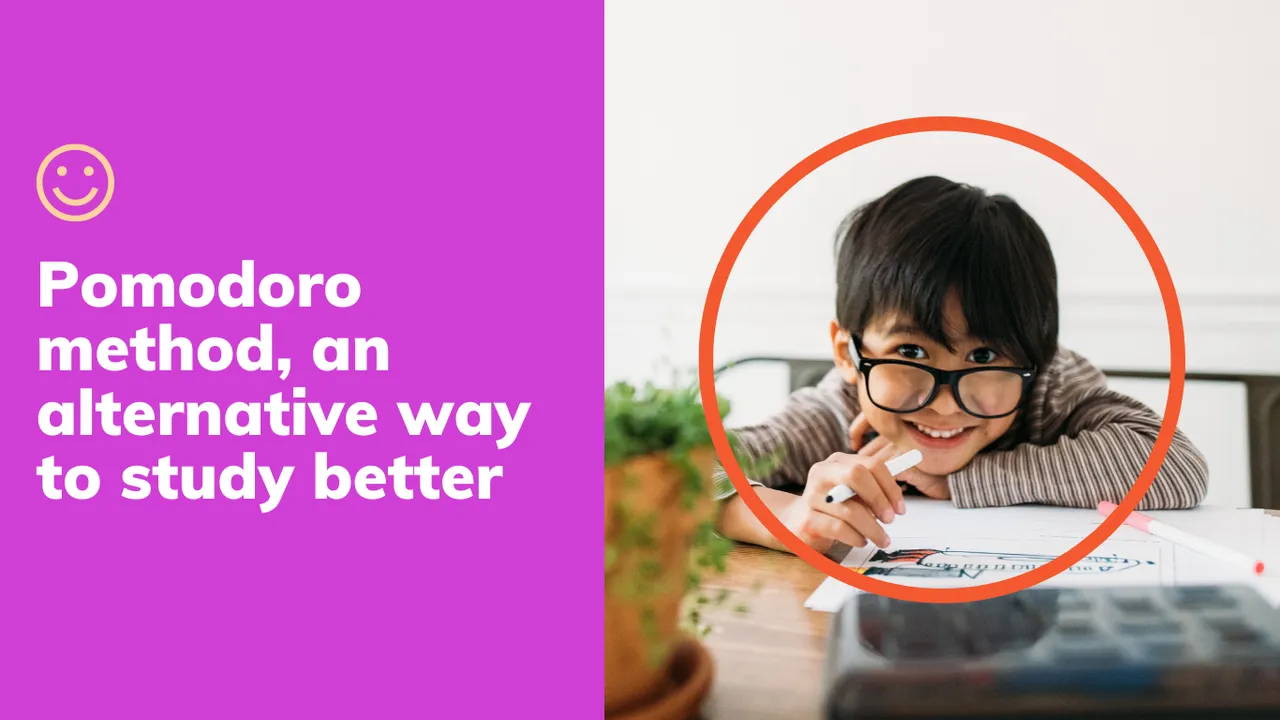ENG
Hello, happy day!

Imagen creada en Canva
I proposed it to him and he accepted. But first, we reworked the questionnaire. I structured it in simple sentences and left spaces between lines to make it easier to read. When studying with your children for any subject, always try to write the texts in simple sentences, i.e. a subject and a predicate. Then put a full stop or full stop, as appropriate. These sentence structures are easier for children to recognise and engage with, especially if they are in the first years (1st to 4th grade) and find it difficult to learn a text.
Going back to the pomodoro method, after organising everything, putting the T.V. on mute and turning the pc upside down, we set out to read out loud the text of the exhibition twice and then read it quietly for 25 minutes. I timed it with the stopwatch on my phone. We rested, rested for 5 minutes and then restarted again for 25 minutes and rested again for 5 minutes. We did this four times and rested for 20 minutes. In between the rest times, we went back to listening to the TV, but we also did things like picking up the room, watering the plants and so on.

During the 20-minute break, I did allow him to use the computer. Once that time had passed, we repeated the dynamics of the first block several times and You Know What? Andrés (that's my nephew's name) managed to learn the content and not only that, he managed to read aloud more fluently. In addition, he was also able to practice the exposition without the need to have the chuletica in his hand and I also noticed that the more he appropriated the content of the text, the more he moved away from the text we had constructed together, because he began to say it in his own words, which was a success, because we did not want a learning by heart or caletre, as we call it in Venezuela.
Andrés retained the knowledge some time later, because he was unable to do the presentation on the scheduled day, and this seems to me to be very good, because it did not happen as on other occasions when he forgot the presentation. Now, this method, although it has a merely repetitive and memoristic character, allows the act of studying not to be tormenting either for the child or for the parent, who in his heart of hearts would like his child to learn at his own pace and ends up drowning in a sea of frustration.
The idea of studying is an issue for anyone who has the task of preparing their children. For my part, I have always thought that if you don't have the patience to teach your child, it is best to seek help from private tutoring. Not everyone is born with the patience to teach and our children do not go at our pace, for that reason, a person who knows the educational chores, would be the best option.

But, if you have no other choice, the best thing to do would be to promote a healthy and friendly educational dynamic. Always study at the same time, in the same place, without distractions, approach activities according to the order in which they should be presented, and a lot of things that allow us to give structure to our children and also to put this method into practice. Obviously, it takes a bit of effort and discipline on both sides, but once it settles into our activities, it can work well.
What kind of activities would you use it for? For an exhibition, for memorising formulas in mathematics, for locating states on a map in geography, for learning some spelling rules, for example, accentuation rules, for learning terms in biology...
Would you apply it to areas such as art? Probably not, simply because the activities in these subjects aim to make the student explore and exploit his or her creativity, so working with a scheme like the Pomodoro Method would not work.
Finally, what do I need? As I said a few paragraphs above, you need to have the text organised, avoid distractions and a stopwatch at hand to keep time and most importantly, the willingness of the parent to apply it, because at that moment you are the one who commands the educational act, so do not get frustrated if you see that at the beginning it is difficult, they will soon adapt and you will see the benefits.
Without a doubt, I think that anything that helps to improve the dynamics of doing homework, it will always be good to put it into practice until we find the one that best suits our needs and ensure that the time to study does not become a time of terror.
Best regards...
[ESP]

Imagen creada en Canva
Se lo propuse y él aceptó. Pero, antes, rehicimos el cuestionario. Lo estructuré en oraciones simples y dejé espacios entre línea y línea para facilitar la lectura. Cuando estudien con sus hijos para cualquier tema, procuren escribir siempre los textos con oraciones simples, es decir, un sujeto y un predicado. Después colocar un punto y seguido o punto y aparte, según convenga. Esas estructuras oracionales son más fáciles para el reconocimiento y enganche de los chamos, sobre todos, si están en los primeros años (1ero a 4to grado) y les cuesta aprenderse un texto.
Retomando lo del método pomodoro, después de organizar todo, poner en mute el T.V. y voltear la pc, nos dispusimos a leer en voz alta el texto de la exposición dos veces y luego en voz baja por 25 minutos. El tiempo lo llevé con el cronometro de mi teléfono. Descansamos, 5 minutos y retomamos nuevamente por 25 minutos y volvimos a descansar por 5 minutos. Así lo hicimos cuatro veces y descansamos 20 minutos. Entre los tiempos de descanso, volvimos a escuchar la T.V, aunque también hicimos cosas como recoger el cuarto, regar las plantas y así.

En el descanso de 20 minutos, si le permití usar la computadora. Una vez transcurrido ese tiempo, repetimos la dinámica del primer bloque varias veces y ¿Saben Qué? Andrés (así se llama mi sobrino) logró aprenderse el contenido y no sólo eso, logró leer en voz alta de forma más fluída. Además, también fue capaz de practicar la exposición sin la necesidad de tener la chuletica en la mano y también noté, que mientras más se apropiaba del contenido del texto, más se alejaba del texto que junto construimos, porque comenzó a decirlo con sus propias palabras, lo cual, fue todo un éxito, porque no queríamos un aprendizaje de memoria o caletre, como lo llamamos en Venezuela.
Andrés conservó el conocimiento tiempo después, porque no pudo hacer la exposición para el día pautado y eso me parece muy bueno, porque no sucedió como en otras oportunidades que olvidó la exposición. Ahora bien, este método, aunque tiene un carácter meramente repetitivo y memorístico, permite que el acto de estudiar no sea tormentoso ni para el niño, ni para el padre, al que en el fondo de su corazón le gustaría que su hijo aprendiera a su ritmo y termina ahogándose en una mar de frustraciónes.
La ideas de estudiar es todo un tema para todo aquel que tiene la tarea de dedicarse a preparar a sus hijos. Por mi parte, siempre he pensado que si no se tiene paciencia para enseñarle a un hijo, es mejor que opte por buscar ayuda en clases particulares. No todos nacen con la paciencia para enseñar y nuestros hijos no van a nuestro ritmo, por tal razón, una persona que conozca de los quehaceres educativos, sería la mejor la opción.

Pero, si no te queda de otra, pues lo mejor sería promover una sana y amigable dinámica educativa. Estudiar siempre a la misma hora, en el mismo lugar, sin distracciones, abordar las actividades según el orden en el que debe presentarlas y un montón de cosas que permitan darle estructura a nuestros hijos y también poner en práctica este método. Evidentemente, necesita un poco de esfuerzo y disciplina de ambas partes, pero una vez que se asienta en nuestras actividades, puede dar buenos resultados.
¿Para que tipo de actividades lo apicaría? Para una exposición, para memorizar fórmulas en el área de matemática, para ubicar los estados en un mapa en la clase de geografía, para aprender algunas reglas ortográficas, como por ejemplo, las reglas de acentuación, para aprender términos en el área de biología...
¿Lo aplicaría para áreas como artística? Es posible que no, simplemente, porque las actividades de estas asignaturas buscan hacer que el estudiante explore y explote su creatividad, por lo que trabajar con un esquema como el del Método Pomodoro, no serviría.
Por último, ¿Qué necesito? Como te dije unos parrafos más arriba, es necesario tener organizado el texto, evitar las distracciones y un cronómetro a la mano para llevar el tiempo y lo más importante, disposición del padre a madre para aplicarlo, porque en ese momento eres tú el que comanda el acto educativo, así que no te frustres si ves que al comienzo es difícil, pronto se adaptará y verás los beneficios.
Sin duda, creo que todo lo que contribuya a mejorar la dinámica de hacer tareas, siempre será bueno ponerlo en práctica hasta ubicar el que mejor adapte a nuestras necesidades y garantizar que el momento de estudiar no se convierta en la hora del terror.
Saludos...